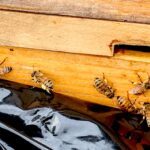
By Sadie Forbes
Most people visiting Rock Meadow have noticed the presence of beehives. Belmont beekeepers now tend 20 hives in five locations along Mill Street and in the center of the meadow.
There are many pressures on honeybees. Beekeepers and scientists agree that two problems are largely responsible for “colony collapse disorder,” where entire hives of bees die off.
The first cause is varroa mites (Varroa destructor). These mites were benign pests of Asian honeybees (Apis cerana) in Asia. Beginning in the 1980s, varroa mites began to be seen in western apiaries. They have been highly destructive to the Western honey bees (Apis mellifera).
Second, a large proportion (about 80%) of all US honeybee colonies are transported by truck to do pollination work for the California almond crop, where they are exposed to extremely high levels of chemical pesticides and fertilizers. These chemicals affect bees’ immune systems, making them vulnerable to disease. Unfortunately for the bees, trucking bees to California pays commercial beekeepers better than most other work.
It is also difficult to find bees and queen bees for starting local colonies that weren’t raised in the southern United States and trucked nationwide. Not surprisingly, bees that succeed in southern climates do not fare as well in the northern states. To address this problem, Rock Meadow’s beekeepers work with local queen breeders in western Massachusetts, and some of the Rock Meadow apiarists are learning to breed queens that will survive optimally in eastern Massachusetts.
Managing honeybees through the seasons
The natural cycle of a bee colony is to build up the hive’s population in spring and into summer. When the colony has grown to the point of overcrowding, the queen leaves the hive, taking a cohort with her to “swarm” and take up residence in a new location.
Beekeepers monitor hive populations and will “split” a hive to form two colonies, simulating the swarm. At that point, a beekeeper will either rely on the remaining bees to raise a queen, or the beekeeper can purchase a new queen with desirable characteristics.
A queen bee lays up to 2,000 eggs daily that mature into workers and drones in about two weeks. Many of the worker bees are assigned to care for the queen and the brood she’s rearing. However, high-quality drones are just as crucial to the ongoing health of all hives in an area. Virgin queens mate with drones in “drone congregation areas.” If the drones that breed a new queen are not allowed sufficient space in a hive, or if they come from a hive that is not healthy, their offspring will be weak.
Solutions for mites
Hygiene is a primary defense against varroa mites. Methods include:
- Actively creating 2-week periods for a colony to have no brood and, therefore, no place for the mites to propagate. This practice is called “brood breaks.”
- Applying “natural” organic deterrents, e.g., formic acid, oxalic acid, or thymol.
- Applying synthetic miticides, the lowest-effort step. Unfortunately, mites become resistant to these agents in less than a year after application.
Honeybees and native pollinators
Western honey bees (Apis mellifera) naturally occur in Africa, Europe, and the Middle East. They have been domesticated for nearly 9,000 years. They have been selectively bred by humans as managed livestock. They are also a domesticated species tied tightly to small- and large-scale agriculture.
Native bee species include bumblebees, carpenter bees, and various butterflies and wasps. Native pollinators tend to be specialists, and are most effective in pollinating specific plants.
Most people know that monarch butterflies are highly specialized in pollinating milkweed and migrate up to 2,500 miles. Bumblebees are essential pollinators of rare and imperiled wildflowers, including native monkshood; they’re also highly effective for tomatoes, peppers, raspberries, and other row crops.
In contrast, European honeybees are generalists and the most efficient honey producers—hence their wide domestication. In addition to competing for resources, they can have indirect albeit adverse effects, especially on bumblebees. High levels of varroa in honeybee colonies often result in high rates of deformed wing virus in the bees, which will effectively kill a colony. Bumblebees are also prone to this infection, and poorly managed honeybee colonies harm local honeybee colonies and the local bumblebee population.
Honeybees forage and breed over a wide range, flying up to three miles. We tend to think primarily about our hives’ immediate environment, which is Rock Meadow. However, the bees of Rock Meadow likely travel west as far as Route 95/128, east across most of Arlington, north into the middle of Lexington, and south as far as the Charles River.
The beekeepers of Rock Meadow work together for consensus on how best to be a positive presence for the community gardens, for people enjoying this beautiful space, and for hives in the larger region.
Sadie Forbes is a research scientist working at MIT.



Sorry, the comment form is closed at this time.